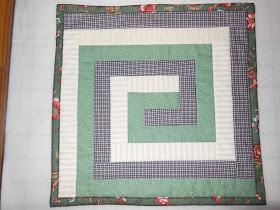 |
Layered, Quilted and Bound
The wall-hanging measures 22-1/2" square |
Although I was not aware of it at the time I wrote this post, a
printed pattern for this wall-hanging is available for sale. The pattern will guide and help you to assemble the pieces of the jig-saw puzzle.
This quilt was started as a
Christmas in July project, just after I'd acquired the
Li'l Twister tool. The tool simplified the construction of this quilt because of the little feet on the underside of the ruler that grip the fabric and raise the ruler off the seams to make it easier to cut out the 3-1/2" squares.
Or you can
make your own template using a 3-1/2" square ruler.
 |
| Make your own template |
I used a charm pack called Winterscapes, manufactured by Benartex, which was purchased from
Craftsy.
 |
| Winterscapes 5" square Charm Pack |
The inspiration for this quilt came from a post on
The Knitting Quilter. I imitated the fabric configuration to achieve the wreath effect and used graph paper and colored pencils to keep the design straight.
The white squares form a cross in the center and cornerstones in this configuration and the whole block is surrounded by a 3-1/2" border.
 |
Red, White and Green Fabric Configuration
using 5" squares from the charm pack |
Tips:
I made sure to consistently place the logo on the Li'l Twister tool in the bottom right hand corner of each square.
I also made a conscious decision to cut the squares from top to bottom and left to right.
The third tip is to cut each square and place it immediately on a design wall in the same order it came off the above block.
Once all the 3-1/2" squares are cut and placed on the design wall, the pinwheels or whirlygigs become noticeable.
 |
| Cut squares are placed on work surface |
After the horizontal columns are chain-sewn, each row was attached to the row below it and the entire block took on the appearance of a perforated curtain. I pressed odd rows to the left and even rows to the right so that seams were nested which always makes sewing easier.
 |
| Horizontal columns are chain-sewn |
 |
| All the vertical rows are sewn down |
I chose a Christmas tree fabric for the borders. The quilt was measured across the center, horizontally, and two borders were cut to this length and sewn to the top and bottom.
 |
| Horizontal borders are attached |
The quilt was measured down the center, vertically, after the two horizontal borders were added and two borders were cut to this length and sewn to the sides. A multi-colored rickrack was sewn along the seam between the quilt top and borders.
 |
| Multi-colored rickrack sewn along seams |
The quilt top was layered with batting and the same border fabric was used on the back. I chose to quilt around the outline of the pinwheels. This quilting is more visible on the back of the quilt.
 |
| Quilting on back of quilt |
I made straight-edge binding from the same Christmas fabric that is on the borders and the back. The mitered corners came out really well because of a neat trick I tried for the first time. I was aiming for a half inch binding. After quilting the quilt, I trimmed the batting and backing a quarter inch away from the four sides of the quilt top. During the binding step, I stopped stitching 1/2" from each corner, turned the quilt and back-stitched all the way off the top of the quilt. I then removed the quilt from the sewing machine, folded the binding up at a 45 degree angle to the corner and folded it down along the top edge of the batting (instead of aligning it with the quilt top) and then down the side of the quilt top. I then sewed a 1/4" seam beginning from the top of the folded edge down the side of the quilt top.
 |
| Perfect mitered corners |
The binding was folded to the back, pinned to make sure the binding on the back covered the sewn line and was sewed in the ditch along the seam of the binding on the front.
 |
| Binding is machine sewn on the back |
This was a most interesting project, and I hope you will give it a try. There are still two and a half months to Christmas, so there's lots of time to get it done!
Cheers!
































